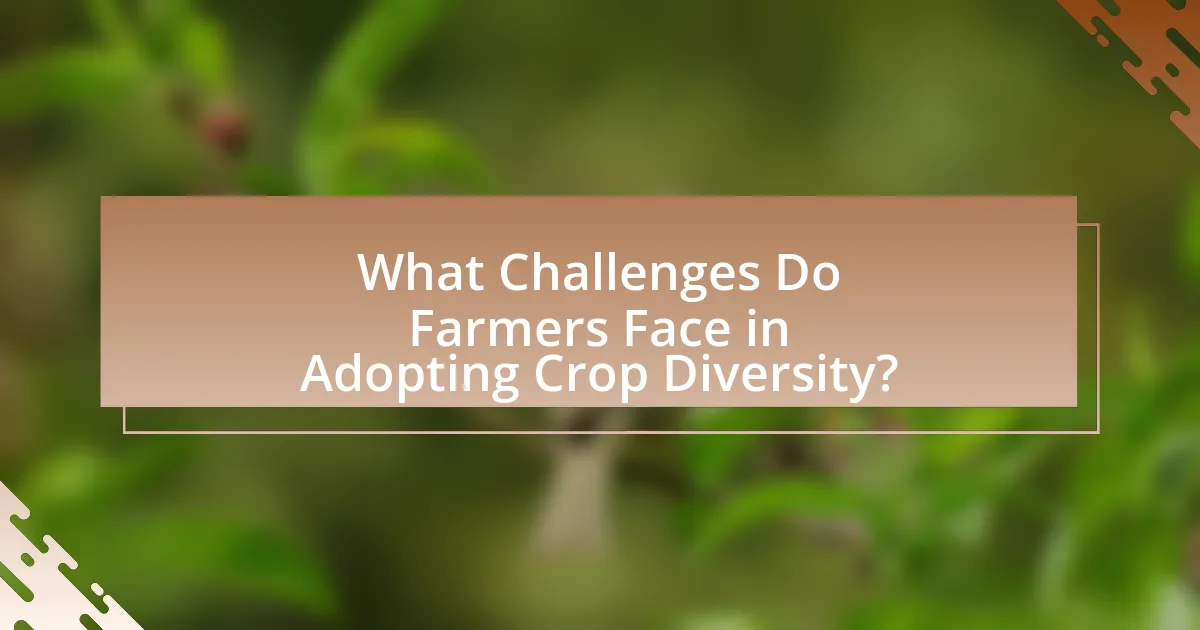Crop diversity is the cultivation of various crops within a specific area, encompassing different species and genetic variations. This practice is crucial for farmers as it enhances ecosystem resilience, improves soil health, and reduces the risk of crop failure due to pests, diseases, or climate change. The article explores the importance of educating farmers on the benefits of crop diversity, highlighting effective educational methods, the role of agricultural extension services, and the use of technology to disseminate information. It also addresses the challenges farmers face in adopting crop diversity, including economic constraints and misconceptions, while providing practical steps for implementation and assessing land suitability for diverse crops.

What is Crop Diversity and Why is it Important for Farmers?
Crop diversity refers to the variety of different crops cultivated in a specific area, encompassing various species and genetic variations within those species. It is important for farmers because it enhances ecosystem resilience, improves soil health, and reduces the risk of crop failure due to pests, diseases, or climate change. Studies show that diverse cropping systems can increase yields by up to 20% compared to monocultures, as they utilize resources more efficiently and provide a buffer against environmental stresses. Additionally, crop diversity supports biodiversity, which is crucial for maintaining ecological balance and promoting sustainable agricultural practices.
How does crop diversity contribute to sustainable agriculture?
Crop diversity contributes to sustainable agriculture by enhancing ecosystem resilience, improving soil health, and increasing crop yields. Diverse cropping systems can better withstand pests and diseases, reducing the need for chemical inputs. For instance, a study published in the journal “Nature” found that farms with higher crop diversity had 20% higher yields compared to monoculture systems, demonstrating the effectiveness of diverse crops in maintaining productivity. Additionally, crop diversity promotes beneficial interactions among plants, which can lead to improved nutrient cycling and reduced soil erosion, further supporting sustainable agricultural practices.
What are the ecological benefits of maintaining crop diversity?
Maintaining crop diversity provides significant ecological benefits, including enhanced resilience to pests and diseases. Diverse crops create a more balanced ecosystem, which can reduce the likelihood of widespread crop failure due to specific pests or pathogens. For instance, studies have shown that polycultures can decrease pest populations by up to 50% compared to monocultures, as diverse plant species can disrupt pest life cycles and reduce their habitat. Additionally, crop diversity promotes soil health by improving nutrient cycling and reducing erosion, as different root structures and plant types contribute to a more robust soil ecosystem. This is supported by research indicating that diverse cropping systems can increase soil organic matter by 20% or more, leading to improved water retention and fertility.
How does crop diversity enhance soil health and fertility?
Crop diversity enhances soil health and fertility by promoting a variety of root structures and microbial communities that improve nutrient cycling and soil structure. Different crops contribute unique organic matter and root exudates, which support diverse soil organisms, leading to increased soil fertility. Research indicates that fields with higher crop diversity can yield 20-30% more than monoculture systems, as diverse crops can better utilize soil nutrients and reduce pest and disease pressures. This is supported by studies showing that polycultures can enhance soil organic carbon levels and improve overall soil health metrics, such as water retention and aeration.
What are the economic advantages of crop diversity for farmers?
Crop diversity provides significant economic advantages for farmers by enhancing resilience against market fluctuations and environmental challenges. By cultivating a variety of crops, farmers can reduce the risk of total crop failure due to pests, diseases, or adverse weather conditions, which in turn stabilizes their income. Research indicates that diversified farming systems can increase overall farm productivity by up to 20% compared to monocultures, as different crops can utilize resources more efficiently and improve soil health. Additionally, crop diversity allows farmers to tap into niche markets and consumer preferences, potentially leading to higher prices for specialty crops. This adaptability not only secures farmers’ livelihoods but also contributes to sustainable agricultural practices, ultimately benefiting the economy as a whole.
How can crop diversity reduce risks associated with crop failure?
Crop diversity can significantly reduce risks associated with crop failure by enhancing ecosystem resilience and minimizing the impact of pests and diseases. When multiple crop varieties are cultivated, the likelihood of total crop loss decreases because different crops respond variably to environmental stresses, such as drought or disease outbreaks. For instance, a study published in the journal “Nature” found that farms with diverse crops experienced 20% less yield loss during adverse weather conditions compared to monoculture farms. This evidence illustrates that crop diversity acts as a buffer against the unpredictability of climate and biological threats, ultimately promoting agricultural stability and food security.
What market opportunities arise from diverse crop production?
Diverse crop production creates market opportunities such as access to niche markets, increased resilience to price fluctuations, and enhanced food security. By cultivating a variety of crops, farmers can target specific consumer preferences, such as organic or heirloom varieties, which often command higher prices. Additionally, diverse cropping systems can mitigate risks associated with monoculture, allowing farmers to stabilize their income even when market prices for certain crops decline. Research indicates that diversified farms can yield 20-60% more than monocultures, enhancing profitability and sustainability.

How Can Farmers Be Educated on the Benefits of Crop Diversity?
Farmers can be educated on the benefits of crop diversity through targeted training programs, workshops, and access to research-based resources. These educational initiatives can highlight the advantages of crop diversity, such as improved soil health, pest resistance, and increased resilience to climate change. For instance, studies have shown that diverse cropping systems can lead to a 20-30% increase in yield stability compared to monocultures, as reported by the Food and Agriculture Organization. Additionally, collaboration with agricultural extension services can facilitate knowledge transfer and provide farmers with practical examples of successful diverse cropping practices.
What educational methods are most effective for farmers?
The most effective educational methods for farmers include hands-on training, peer-to-peer learning, and the use of technology-based resources. Hands-on training allows farmers to directly engage with new practices, enhancing their understanding and retention of information. Peer-to-peer learning fosters community support and knowledge sharing, which has been shown to improve adoption rates of innovative farming techniques. Additionally, technology-based resources, such as mobile apps and online platforms, provide accessible information and real-time data, facilitating informed decision-making. Research indicates that these methods lead to higher levels of engagement and improved agricultural outcomes, as evidenced by studies demonstrating increased crop yields and sustainable practices among farmers who utilize these educational approaches.
How can workshops and field demonstrations enhance understanding?
Workshops and field demonstrations enhance understanding by providing hands-on experience and practical knowledge that theoretical learning cannot offer. These interactive sessions allow farmers to observe and engage with diverse crop practices in real-time, facilitating immediate feedback and clarification of concepts. Research indicates that experiential learning, such as that found in workshops, significantly improves retention and application of knowledge, as evidenced by a study published in the Journal of Agricultural Education and Extension, which found that participants in hands-on training showed a 30% increase in knowledge retention compared to traditional classroom settings. This direct engagement with the material fosters a deeper comprehension of crop diversity benefits, ultimately leading to more informed agricultural practices.
What role do agricultural extension services play in farmer education?
Agricultural extension services play a crucial role in farmer education by providing essential knowledge and resources that enhance agricultural practices. These services facilitate the dissemination of research-based information, enabling farmers to adopt improved techniques and technologies that increase productivity and sustainability. For instance, a study by the Food and Agriculture Organization (FAO) highlights that effective extension services can lead to a 20-30% increase in crop yields by educating farmers on best practices and crop diversity. This education helps farmers understand the benefits of diversifying their crops, which can lead to improved resilience against pests and climate change.
How can technology facilitate education on crop diversity?
Technology can facilitate education on crop diversity by providing access to digital resources, interactive platforms, and data analytics tools. These technologies enable farmers to learn about various crop species, their benefits, and best practices for cultivation through online courses, webinars, and mobile applications. For instance, platforms like e-learning websites and agricultural apps offer tailored information on crop diversity, helping farmers make informed decisions. Additionally, data analytics can help farmers understand local soil conditions and climate impacts, promoting the selection of diverse crops suited to their environment. Studies have shown that farmers who utilize technology for education are more likely to adopt diverse cropping systems, leading to improved resilience and productivity in agriculture.
What digital tools can be used to share information with farmers?
Digital tools that can be used to share information with farmers include mobile applications, social media platforms, and online agricultural forums. Mobile applications like AgroStar and Plantix provide farmers with access to expert advice, pest identification, and crop management tips directly on their smartphones. Social media platforms such as Facebook and WhatsApp facilitate community engagement and information sharing among farmers, allowing them to exchange experiences and best practices. Online agricultural forums, like AgFunder Network Partners, enable farmers to connect with agricultural experts and access a wealth of resources, including research articles and market trends. These tools enhance communication and knowledge dissemination, ultimately supporting farmers in adopting diverse cropping practices.
How can social media campaigns raise awareness about crop diversity?
Social media campaigns can raise awareness about crop diversity by disseminating information and engaging communities through targeted content. These campaigns utilize visual storytelling, infographics, and interactive posts to highlight the importance of diverse crops for sustainable agriculture and food security. For instance, studies show that diverse cropping systems can enhance resilience against pests and diseases, which is crucial for farmers facing climate change challenges. By sharing success stories and educational resources, social media platforms can effectively reach a wide audience, fostering a community that values and promotes crop diversity.

What Challenges Do Farmers Face in Adopting Crop Diversity?
Farmers face several challenges in adopting crop diversity, including economic constraints, lack of knowledge, and market access issues. Economic constraints often arise from the initial investment required for diverse seeds and the potential risk of lower yields during the transition period. Additionally, many farmers may lack access to information and training on the benefits and techniques of crop diversity, which can hinder their ability to implement these practices effectively. Market access issues also pose a significant challenge, as farmers may struggle to find buyers for diverse crops, which can lead to financial losses. These challenges are supported by studies indicating that economic viability and knowledge gaps are critical barriers to the adoption of diverse cropping systems.
What are the common misconceptions about crop diversity?
Common misconceptions about crop diversity include the belief that monoculture is more efficient, that diverse crops require more resources, and that crop diversity is only relevant for small-scale farming. Monoculture, while it may seem efficient, often leads to increased vulnerability to pests and diseases, as evidenced by the Irish Potato Famine, which resulted from reliance on a single potato variety. The idea that diverse crops require more resources is misleading; in fact, diverse cropping systems can enhance soil health and reduce the need for chemical inputs, as shown in studies by the Food and Agriculture Organization. Lastly, the notion that crop diversity is only beneficial for small farms ignores the advantages it offers to large-scale agriculture, such as improved resilience to climate change and market fluctuations, supported by research from the International Food Policy Research Institute.
How can misinformation be addressed in farmer education?
Misinformation in farmer education can be addressed through the implementation of evidence-based training programs that emphasize accurate agricultural practices. These programs should incorporate verified research findings, such as those from the Food and Agriculture Organization, which highlight the benefits of crop diversity in enhancing resilience against pests and climate change. Additionally, utilizing local agricultural extension services to disseminate reliable information can help counteract false narratives and provide farmers with access to expert advice. Engaging farmers in participatory learning approaches, where they can share experiences and validate information collectively, further strengthens the credibility of the education provided.
What psychological barriers might farmers face in changing practices?
Farmers may face several psychological barriers when changing practices, including fear of the unknown, resistance to change, and a lack of confidence in new methods. Fear of the unknown can stem from concerns about the potential risks and uncertainties associated with adopting new agricultural practices, which may lead to hesitation in making changes. Resistance to change is often rooted in established routines and traditions, making it difficult for farmers to shift away from familiar practices. Additionally, a lack of confidence in their ability to implement new techniques can hinder farmers from exploring innovative approaches, as they may doubt their skills or the effectiveness of alternative methods. These psychological barriers can significantly impede the adoption of crop diversity practices, which are essential for sustainable agriculture.
How can financial constraints impact the adoption of crop diversity?
Financial constraints significantly hinder the adoption of crop diversity by limiting farmers’ ability to invest in diverse seed varieties and necessary agricultural practices. When farmers face financial limitations, they often prioritize short-term, high-yield crops that require less investment over the long-term benefits of diverse cropping systems. Research indicates that farmers with limited financial resources are less likely to experiment with or adopt new crop varieties, as they cannot afford the risks associated with potential crop failure or lower immediate returns. For instance, a study by the Food and Agriculture Organization (FAO) highlights that financial barriers can lead to a reliance on monoculture, which reduces resilience to pests and climate variability, ultimately impacting food security.
What funding opportunities exist to support farmers in diversifying crops?
Funding opportunities to support farmers in diversifying crops include government grants, loans, and programs specifically aimed at promoting agricultural diversity. For instance, the USDA offers the Specialty Crop Block Grant Program, which provides funding to enhance the competitiveness of specialty crops, encouraging farmers to diversify beyond traditional crops. Additionally, the Sustainable Agriculture Research and Education (SARE) program funds projects that promote sustainable farming practices, including crop diversification. These funding sources are designed to help farmers adopt new crops, improve soil health, and increase resilience against market fluctuations and climate change.
How can cooperative models help mitigate financial risks?
Cooperative models can mitigate financial risks by pooling resources and sharing costs among members, which reduces individual financial burdens. By collaborating, farmers can access shared services such as bulk purchasing of seeds and equipment, leading to lower prices and improved profitability. Additionally, cooperatives can provide collective marketing strategies, enhancing market access and stabilizing income through diversified crop offerings. Research indicates that cooperatives can increase farmers’ income by up to 30% through these collaborative efforts, demonstrating their effectiveness in risk reduction.
What Practical Steps Can Farmers Take to Implement Crop Diversity?
Farmers can implement crop diversity by rotating different crops in their fields each season. Crop rotation enhances soil health, reduces pest and disease cycles, and improves yields. For instance, alternating legumes with cereals can fix nitrogen in the soil, benefiting subsequent crops. Additionally, farmers can interplant various species within the same field, which can lead to increased resilience against pests and environmental stressors. Research shows that farms practicing diverse cropping systems can yield up to 20% more than monoculture systems, demonstrating the effectiveness of these practices in enhancing productivity and sustainability.
What are the best practices for integrating diverse crops into existing systems?
The best practices for integrating diverse crops into existing systems include crop rotation, intercropping, and agroforestry. Crop rotation enhances soil health and reduces pest and disease cycles, as evidenced by studies showing that rotating legumes with cereals can improve nitrogen levels in the soil. Intercropping, which involves growing two or more crops in proximity, can increase biodiversity and optimize resource use, with research indicating that intercropped systems can yield up to 20% more than monocultures. Agroforestry combines agriculture and forestry practices, promoting biodiversity and improving ecosystem services, supported by findings that agroforestry systems can sequester more carbon than conventional farming. These practices collectively contribute to sustainable agricultural systems by enhancing resilience, productivity, and ecological balance.
How can farmers assess their land for suitable crop diversity options?
Farmers can assess their land for suitable crop diversity options by conducting soil tests, analyzing climate conditions, and evaluating local biodiversity. Soil tests provide essential information on nutrient levels, pH, and organic matter, which influence crop growth. For instance, a study by the USDA indicates that soil health directly affects crop yield and diversity potential. Analyzing climate conditions, such as temperature and rainfall patterns, helps farmers select crops that are well-suited to their environment. Additionally, evaluating local biodiversity can guide farmers in choosing crops that complement existing ecosystems, enhancing resilience and productivity.










